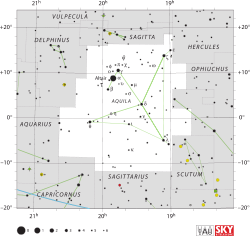Kappa Aquilae

| |
| Observation data Epoch J2000 Equinox J2000 | |
|---|---|
| Constellation | Aquila |
| Right ascension | 19h 36m 53.44952s[1] |
| Declination | –7° 01′ 38.9176″[1] |
| Apparent magnitude (V) | +4.957[2] |
| Characteristics | |
| Spectral type | B0.5 III[3] |
| U−B color index | –0.861[2] |
| B−V color index | –0.028[2] |
| Astrometry | |
| Radial velocity (Rv) | –19.4[4] km/s |
| Proper motion (μ) | RA: +1.63[1] mas/yr Dec.: –2.65[1] mas/yr |
| Parallax (π) | 1.94 ± 0.20[1] mas |
| Distance | approx. 1,700 ly (approx. 520 pc) |
| Details | |
| Mass | 15.50 ± 0.61[5] M☉ |
| Radius | 12.5[6] R☉ |
| Luminosity | 52,630[5] L☉ |
| Surface gravity (log g) | 3.5[7] cgs |
| Temperature | 26,500[5] K |
| Rotational velocity (v sin i) | 265[8] km/s |
| Age | 11.1 ± 0.5[3] Myr |
| Other designations | |
Kappa Aquilae (κ Aql, κ Aquilae) is the Bayer designation for a star in the equatorial constellation of Aquila. It is a faint star at apparent visual magnitude +4.957,[2] but bright enough to be seen with the naked eye in dark suburban skies. The annual parallax is only 1.94 mas,[1] which equates to a distance of approximately 1,700 light-years (520 parsecs) from Earth (with a 10% margin of error).
The spectrum of Kappa Aquilae matches a stellar classification of B0.5 III,[3] where the luminosity class of III is typically associated with evolved giant stars. This is a huge star with 15.50[5] times the Sun's mass and 12.5[6] times the radius of the Sun. Massive stars like this blaze brightly; it is radiating 52,630-fold[5] the Sun's luminosity from its outer atmosphere with a scorching effective temperature of 26,500 K,[5] giving it the intense blue-white glow of a B-type star. It is only 11 million years of age[3] and is spinning rapidly with a projected rotational velocity of 265 km/s.[8]
References
- 1 2 3 4 5 6 van Leeuwen, F. (November 2007), "Validation of the new Hipparcos reduction", Astronomy and Astrophysics, 474 (2): 653–664, arXiv:0708.1752
 , Bibcode:2007A&A...474..653V, doi:10.1051/0004-6361:20078357.
, Bibcode:2007A&A...474..653V, doi:10.1051/0004-6361:20078357. - 1 2 3 4 Gutierrez-Moreno, Adelina; et al. (1966), A System of photometric standards, 1, Publicaciones Universidad de Chile, Department de Astronomy, pp. 1–17, Bibcode:1966PDAUC...1....1G.
- 1 2 3 4 Tetzlaff, N.; Neuhäuser, R.; Hohle, M. M. (January 2011), "A catalogue of young runaway Hipparcos stars within 3 kpc from the Sun", Monthly Notices of the Royal Astronomical Society, 410 (1): 190–200, arXiv:1007.4883
 , Bibcode:2011MNRAS.410..190T, doi:10.1111/j.1365-2966.2010.17434.x.
, Bibcode:2011MNRAS.410..190T, doi:10.1111/j.1365-2966.2010.17434.x. - ↑ Wielen, R.; et al. (1999), Sixth Catalogue of Fundamental Stars (FK6). Part I. Basic fundamental stars with direct solutions (35), Astronomisches Rechen-Institut Heidelberg, Bibcode:1999VeARI..35....1W.
- 1 2 3 4 5 6 Hohle, M. M.; Neuhäuser, R.; Schutz, B. F. (April 2010), "Masses and luminosities of O- and B-type stars and red supergiants", Astronomische Nachrichten, 331 (4): 349, arXiv:1003.2335
 , Bibcode:2010AN....331..349H, doi:10.1002/asna.200911355.
, Bibcode:2010AN....331..349H, doi:10.1002/asna.200911355. - 1 2 Underhill, A. B.; et al. (November 1979), "Effective temperatures, angular diameters, distances and linear radii for 160 O and B stars", Monthly Notices of the Royal Astronomical Society, 189: 601–605, Bibcode:1979MNRAS.189..601U, doi:10.1093/mnras/189.3.601.
- ↑ Frémat, Y.; et al. (September 2005), "Effects of gravitational darkening on the determination of fundamental parameters in fast-rotating B-type stars", Astronomy and Astrophysics, 440 (1): 305–320, arXiv:astro-ph/0503381
 , Bibcode:2005A&A...440..305F, doi:10.1051/0004-6361:20042229.
, Bibcode:2005A&A...440..305F, doi:10.1051/0004-6361:20042229. - 1 2 Abt, Helmut A.; Levato, Hugo; Grosso, Monica (July 2002), "Rotational Velocities of B Stars", The Astrophysical Journal, 573 (1): 359–365, Bibcode:2002ApJ...573..359A, doi:10.1086/340590.
- ↑ "kap Aql -- Star", SIMBAD Astronomical Database, Centre de Données astronomiques de Strasbourg, retrieved 2012-01-13